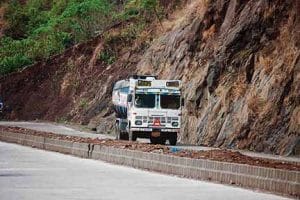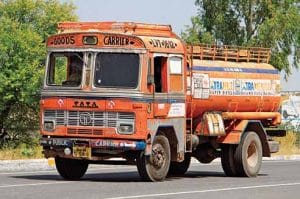Combating Covid-19 for the road freight (transport) fraternity has been full of surprises and some unprecedented challenges.
Story by Senthil Kumar Subbiah
Possessing one of the largest road networks in the world, spanning about 5.5 km, the arrival and road large spread of Covid-19 since February 2020 has thrown some nasty surprises and unprecedented challenges in front of the road freight (transport) fraternity. As part of the logistics industry in India, the fraternity, due to its intrinsic nature, has had to deal with some seemingly insurmountable challenges. As a primary driver of the logistics industry in India given its reliance on road freight (transport), the fraternity saw itself being greatly affected by the rising menace of Covid-19 in the country. As a key point of access for most of the major economic contributing sectors of the industries (such as automotive, retail, chemicals, electronics, healthcare, etc.), the road freight (transport) fraternity, which contributes to the carriage of over 60 per cent of freight in India, has had to adapt, innovate and find new ways to deal with the challenges brought about by the Covid-19 situation. Such has been the effect of Covid-19, that combating it has become the primary objective of the fraternity.
Almost perpetually troubled by factors like shortage of skilled drivers, the road freight (transport) fraternity has for the last few years seen road transport increase however gradually. While credit in part should be given in part at least to the government initiatives to improve logistics infrastructure connectivity between cities, towns and villages, the fraternity, continuing to be highly fragmented, has come to play a significant role in freight transportation in India. Troubled by factors like lack of price transparency and underutilisation of assets as well, it is staring at a significant supply-demand gap against rapidly growing volumes where one driver would be available for every two trucks on the road by 2022. With an estimated one-million truck drivers needed every year for the next 10 years by the road freight (transport), the Covid-19 situation has added to the already complex situation. Necessitating an ability to combat it, the fraternity is seen to be fighting on many fronts at the same time.
The COVID-19 Outbreak
 With over 170 districts across the country having been identified as Covid-19 hot spots since the COVID-19 outbreak, and wherein strict containment measures have been adopted, the road freight (transport) fraternity has seen demand ebb. Containment measures imposed by governments have resulted in the temporary closure of factories and manufacturing units, reduction in port operations, and restrictions in people’s movement. This has had a ripple effect across the supply chain, affecting in part, and quite significantly, the truck operators. With the lockdown leading to a sudden deceleration and halt in manufacturing activities, the immediate fallout, the slowdown for logistics demand and road freight transportation, has greatly affected the road freight (transport) fraternity. This, despite the government classifying transportation as an essential service that is exempt from any restrictions. The daily movement of trucks slipping to less than 10 per cent of the normal levels, many fleet owners have had to temporarily suspend their operations; prioritise driver safety, and consider the fall in demand.
With over 170 districts across the country having been identified as Covid-19 hot spots since the COVID-19 outbreak, and wherein strict containment measures have been adopted, the road freight (transport) fraternity has seen demand ebb. Containment measures imposed by governments have resulted in the temporary closure of factories and manufacturing units, reduction in port operations, and restrictions in people’s movement. This has had a ripple effect across the supply chain, affecting in part, and quite significantly, the truck operators. With the lockdown leading to a sudden deceleration and halt in manufacturing activities, the immediate fallout, the slowdown for logistics demand and road freight transportation, has greatly affected the road freight (transport) fraternity. This, despite the government classifying transportation as an essential service that is exempt from any restrictions. The daily movement of trucks slipping to less than 10 per cent of the normal levels, many fleet owners have had to temporarily suspend their operations; prioritise driver safety, and consider the fall in demand.
Severely impacting the long-haul truck movement because of driver shortage and state-border closures, the road freight (transport) fraternity has had to deal with severe under utilisation of vehicles. With trucks-in-transit (transporting non-essentials) left by the side of the road almost, the severe under utilisation of vehicles has been one of the key factors that the fraternity has had to combat with. With restrictions like lack of demand, driver shortage and the non-availability of dhabas and repair facilities across prime long-haul routes, many transporters turned to short-haul operations. If this led to a drastic fall in asset quality, and reduced the average daily movement of trucks to less than 10 per cent (the average kilometers traveled by trucks reduced from 150-200 km per day to a meager 15-20 km per day), an acute shortage of trucks was had. Resulting in port congestion due to shortage of trucks used to remove import containers from ports and transport them to warehouses and factories, the road freight (transport) fraternity, it was clear, was taking to new ways to combat the situation created by Covid-19. In part, it affected the supply chain was also clear.
Surge in demand for distribution of essentials
 While most industries such as aviation, automotive, chemicals, textile, and capital goods manufacture saw their operations dwindle due to the temporary lockdown, the operations of FMCG, food and healthcare industries took a turn for war-footing basis, creating in-turn a unique and unprecedented situation for the road freight (transport) fraternity. Diverting trucks and resources to the transportation of essential goods such as medicine, medical supplies, fruits and vegetables, and milk, the fraternity, on a war-footing basis, took to supplying essentials to people even as a supply chain situation emerged over time. If the road freight fraternity combated the Covid-19 situation by not letting the supply chain to collapse completely, it responded to distribution challenges in the manner best known to it. And, it continues to do so.
While most industries such as aviation, automotive, chemicals, textile, and capital goods manufacture saw their operations dwindle due to the temporary lockdown, the operations of FMCG, food and healthcare industries took a turn for war-footing basis, creating in-turn a unique and unprecedented situation for the road freight (transport) fraternity. Diverting trucks and resources to the transportation of essential goods such as medicine, medical supplies, fruits and vegetables, and milk, the fraternity, on a war-footing basis, took to supplying essentials to people even as a supply chain situation emerged over time. If the road freight fraternity combated the Covid-19 situation by not letting the supply chain to collapse completely, it responded to distribution challenges in the manner best known to it. And, it continues to do so.
With the brick and mortar stores unable to fulfill the demands of the people, e-commerce channels saw a sudden rise in activity. This in-turn had e-commerce companies turning to the logistics sector and their respective transport partners to best deal with the situation. Combating this challenge, and the same time investing resources in educating their drivers and staff to safely navigate through the Covid-19 situation by practicing certain hygiene procedures, the road freight (transport) fraternity responded in positive to the change in demand at the e-commerce end. It responded with alacrity to the ecommerce needs of medicines and groceries especially. In its efforts to combat the Covid-19 situation, the road freight (transport) fraternity responded particularly well to the help e-commerce players tackle the surging demands of online grocery, and as some of the major food delivery apps joined the race to deliver groceries.
Helping other supply chain actors to successfully deal with distribution challenges intensified by panic-buying, the road freight (transport) fraternity, in an effort to offset the loss caused by the reduced movement of vehicles, took to spot pricing model. The model works by hiking the prices drastically when there is a high demand for distribution vehicles. The adoption of spot pricing model by transporters influenced the way online delivery service providers worked until now. The Covid-19 situation saw them adopting a strategic approach thus by delivering in bulk quantities and consolidating neighborhood orders to effectively manage costs and last-mile challenges. With significant measures being taken by the government to ease the movement of trucks in form of e-passes for example for inter-state movement, in their efforts to combat the Covid-19 situation the road freight (transport) fraternity is expected to benefit from the national infrastructure pipeline to which around USD 260 billion has been allocated.
Revival of Road Freight Transportation
Amid a scenario where several road freight associations have demanded the revival of stimulus packages and exemption of toll charges until the lockdown is lifted, the movement of trucks is slowly going back to normal. With the possibility of trucks transporting essentials and non-essentials plying on the roads gaining momentum against reduced restrictions and checkpoints, the revival of road freight transportation is dependent to quite an extent on the protection of drivers and such other front-line workers. The safety of drivers continues to be a major concern amid the need to provide proper personal protective equipment (PPE). Largely underserved due to the shortage of drivers and reduced employment opportunities for CVs, those operators that have managed to digitise to an extent are finding themselves at a vantage position in their fight against the Covid-19 situation. On the whole however, the need to move up the digital ladder has become even more necessary to serve growing volumes without losing sight of efficiency.
Consider digital freight matching platforms for example. They allow shippers to find trucks with the capacity to transport on a real-time basis. The shippers can also get transparent rates and select the trucks that suit their needs. By leveraging the Internet of Things (IoT) and Artificial Intelligence (AI), the road freight (transport) fraternity could use telematics to their greater advantage. They could also use it to serve their customers better. Solving the challenges of price transparency and limited capacity availability, the freight matching platforms are enabling transporters to focus on efficiency improvement. In fact, platforms like these are coming to provide the driver with substantial information on geo-location of pickup and delivery spots, of optimal routes, of fuel stations, toll gates, rest areas, and restaurants en-route. Accessed via handheld devices, the platforms are also providing load assurance for the truck operators. The driver is informed about the next assignment, even before completing the unloading of the current one. Such consistent demand mapping helps optimise truck utilisation and reduce wasted miles, empowering the truck operators to earn more in the process.
Way forward
The COVID-19 outbreak has shown the road freight (transport) fraternity how delicate the supply chain has become. It has shown how companies are forced to re-evaluate their strategies. The heightened safety precautions have required the industry to work in an emergency services mode. They are being required to work such as governments and associations strive to keep the supply chain from breaking down. While it is important to keep the essential supplies flowing, the Covid-19 situation has almost compelled CV operators to prioritise workforce safety by providing PPE kits, masks, gloves, soaps, sanitisers, etc. It is estimated that the Indian logistics industry will rebound in 2021 and grow by seven to 10 per cent. To do so, it would be crucial to gather end-to-end visibility, process flexibility, and an ability to collaborate. Working in silos or as a fragmented segment of a sector will no longer work for the road freight (transport) fraternity. To be able to support their customers, they would have to work together; they will have to anticipate disruptions and mitigate the resulting impacts. Operators would need to draft a comprehensive contingency plan on the possible challenges and quick recovery actions. Doing this would help mitigate such a crisis in the future. Over the long-term, robotics, truck platooning and autonomous trucks looks like the order of the day. It is these measures that should save the truck operators in their moments of crisis.
————————————
Senthil Kumar Subbiah is an industry analyst with specialisation in transportation and logistics practice at Frost & Sullivan. The views expressed by the authors are their personal opinions and do not necessarily reflect the views of the CV magazine.
























